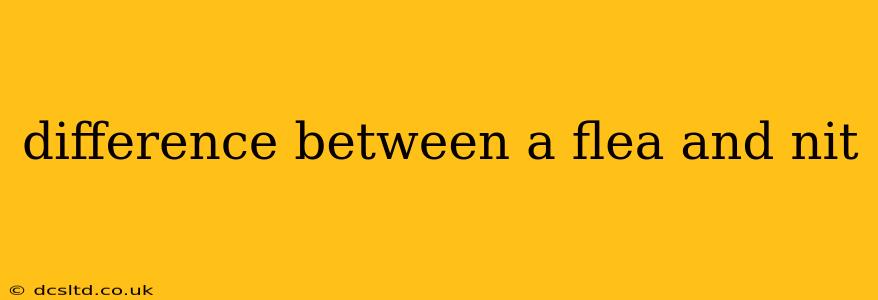Fleas and nits are both small parasites that can infest humans and animals, causing irritation and discomfort. However, they are vastly different creatures, belonging to entirely separate biological classifications. Understanding their key differences is crucial for effective identification and treatment.
What is a Flea?
A flea is a small, wingless insect belonging to the order Siphonaptera. They are parasitic, meaning they feed on the blood of their hosts, typically mammals and birds. Fleas are known for their remarkable jumping ability, allowing them to quickly move between hosts. Their bodies are laterally compressed, enabling them to easily navigate through fur and feathers.
Key characteristics of fleas:
- Six legs: Equipped for jumping and clinging to their hosts.
- Hard exoskeleton: Protects them from crushing.
- Blood-feeding: Requires a blood meal to survive and reproduce.
- High reproductive rate: A single flea can lay hundreds of eggs in its lifetime.
- Vectors of disease: Can transmit diseases like plague and typhus.
What is a Nit?
A nit is the egg of a louse, a wingless insect belonging to the order Phthiraptera. Unlike fleas, lice are generally host-specific, meaning certain species of lice only infest particular animals. Nits are small, oval-shaped, and firmly attached to hair shafts, typically near the scalp. They are often mistaken for dandruff, but careful examination reveals key differences.
Key characteristics of nits:
- Oval shape: Unlike the more elongated shape of a flea.
- Attached to hair: Firmly cemented to the hair shaft, difficult to remove.
- Small size: Often only visible with close inspection.
- White or light-colored: Can appear translucent.
- Develop into lice: After hatching, nits develop into immature lice (nymphs) which mature into adult lice.
What are the key differences between a flea and a nit?
| Feature | Flea | Nit |
|---|---|---|
| Type | Insect | Louse egg |
| Appearance | Small, dark brown, laterally compressed | Small, oval, white or light-colored |
| Mobility | Highly mobile, excellent jumper | Immobile, attached to hair shaft |
| Feeding | Blood-feeding parasite | Non-feeding (develops into a louse) |
| Location | On the skin, in fur or bedding | Attached to hair shafts, usually near scalp |
| Life Cycle | Egg, larva, pupa, adult | Develops into a louse |
How do I tell the difference between a flea and a nit?
The most significant differences lie in their size, shape, mobility, and location. Fleas are mobile insects that jump, while nits are immobile eggs firmly attached to hair. Fleas are darker in color and have a distinct segmented body, unlike the oval, often translucent appearance of a nit. If you suspect an infestation, seeking professional advice from a doctor or pest control expert is recommended for proper identification and treatment.
What are the symptoms of a flea infestation?
Symptoms of a flea infestation include intense itching, small red bites, and the presence of adult fleas on your pet or in your home. You might also notice flea dirt (dried blood) on your pet's fur.
What are the symptoms of a head lice infestation?
Symptoms of head lice infestation include intense itching of the scalp, the presence of adult lice or nits on the hair, and scratching leading to sores or secondary infections.
How are flea and louse infestations treated?
Flea infestations are typically treated with insecticides, thorough cleaning, and sometimes veterinary intervention. Head lice infestations are treated with special shampoos or lotions designed to kill lice and nits. Always follow the instructions on any product carefully. For persistent or severe infestations, consult a medical professional.
By understanding the distinct features of fleas and nits, you can better identify and manage infestations effectively, ensuring the health and well-being of yourself and your pets.
